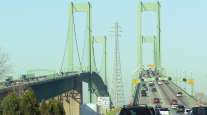Delaware River Bridge to Stay Closed at Least Into April

The Delaware River Bridge, which connects New Jersey and Pennsylvania and has been closed since inspectors found a crack in a supporting truss on Jan. 20, will remain closed a minimum of eight more weeks.
That’s the conclusion of an emergency engineering task force led by the 60-year-old bridge’s co-owners, the New Jersey Turnpike Authority and the Pennsylvania Turnpike Commission. The 1.2 mile-long bridge carries 42,000 vehicles daily via Interstate 276 between Burlington Township in New Jersey and Bristol Township in Pennsylvania.
“It’s a nightmare when you have 42,000 vehicles looking for another way to go,” Gail Toth, executive director of the New Jersey Motor Truck Association, told Transport Topics.
Sam Farruggio, who owns Farruggio’s Express in Bristol, Pennsylvania, said about 10 of his 80-truck fleet are being affected every day by the bridge’s closure. Keeping appointment times and staying within hours-of-service rules have become difficult for the intermodal carrier.
“It’s really hampered our movement between states,” Farruggio told TT. “The opportunity to cross the [free] Scudders Falls Bridge is reduced with the increased volume of traffic. That’s the bridge of choice to go to New Jersey, but with that backed up, you have to go down to Philly to cross [the river,] which is an hour minimum during rush hour, and it’s $37.50 to cross the Walt Whitman Bridge with an E-ZPass. But nobody got hurt [with the crack in the Delaware River Bridge,] which is a great thing. It’s temporary. We’ll survive this.”
The crack was discovered on the Pennsylvania side of the bridge during a routine inspection of a bridge painting project. According to the Pennsylvania Turnpike Commission, the fracture caused the section of the bridge between the two supporting piers to drop by about 2 inches as the load was redistributed. Those components were not designed to carry a heavier load, so the bridge was closed.
“When a painter finds the damage, it scares me,” Farruggio said. “This bridge has probably been under [reconstruction] for two years, and a painter finds the crack? Something’s wrong with our inspection process or maintenance.”
The task force, which consists of more than 20 public and private engineering design, construction and transportation entities, concluded that an early April reopening is the best-case scenario.
"That best-case scenario entails repairing the I-beam by constructing a permanent splice to reconnect the fractured section," PTC Chief Engineer Brad Heigel explained. "But before that can occur, crews must first realign the bisected segment by deploying eight temporary towers and hydraulic jacks to return the span to its original position.
“As load is transferred within the bridge, instrumentation will monitor the actual loads, stresses and displacements, which will be compared to estimated outcomes from computer models,” Heigel added. “This monitoring — which involves affixing about 50 sensors to the structure — is the only way we can confirm that the splice is successful before we reopen the bridge.”
If the data gathered during load testing show that the fix didn’t work, a more complex partial reconstruction of the impacted portion would have to be tried, barring replacing the entire bridge.
“If more extensive repairs would be required, it is not possible to offer even a rough estimate on the scope or duration of further construction because we simply do not have adequate information to make that projection,” Heigel said.
PTC Chairman Sean Logan asked for patience as the construction experts do their jobs.
“We recognize that those who travel through, live, or work in this region have been considerably inconvenienced by this closure,” Logan said. “But please remember this is an emergency situation. We’re working around the clock to resolve it. It would be reckless to put a single vehicle back onto this structure before we trust its stability.”




